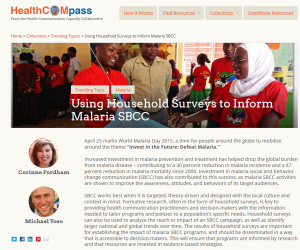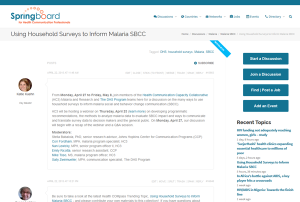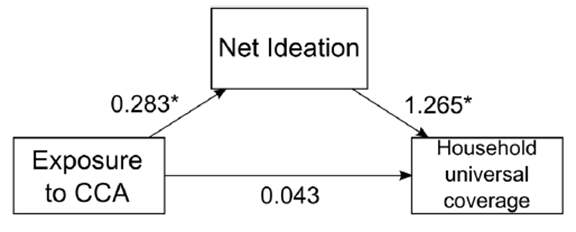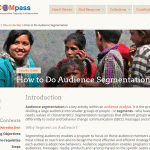Continuing the Discussion on Using Household Surveys to Improve Malaria SBCC
 Household surveys are key tools for health practitioners and social behavior change communication (SBCC) specialists. The information they provide can help us to create relevant and tailored SBCC campaigns, identify priority populations and global trends and strengthen the evidence base for the impact of malaria SBCC. For the April 23 webinar on Using Household Surveys to Improve Malaria SBCC, the Health Communication Capacity Collaborative (HC3) assembled a series of presenters to share their experiences with using household surveys for formative research, program evaluation, and communication and advocacy. This webinar was a part of a series of events HC3 conducted for World Malaria Day, which includes a Health COMpass Trending Topics page and a Springboard for Health Communication Professionals Discussion Forum on household surveys.
Household surveys are key tools for health practitioners and social behavior change communication (SBCC) specialists. The information they provide can help us to create relevant and tailored SBCC campaigns, identify priority populations and global trends and strengthen the evidence base for the impact of malaria SBCC. For the April 23 webinar on Using Household Surveys to Improve Malaria SBCC, the Health Communication Capacity Collaborative (HC3) assembled a series of presenters to share their experiences with using household surveys for formative research, program evaluation, and communication and advocacy. This webinar was a part of a series of events HC3 conducted for World Malaria Day, which includes a Health COMpass Trending Topics page and a Springboard for Health Communication Professionals Discussion Forum on household surveys.
Grace Awantang, Senior Research Data Analyst at the Johns Hopkins Center for Communication Programs (CCP) presented the results of a survey looking at attitudes and behaviors around bed net use, IPTp uptake and malaria case management in Madagascar. The study revealed a number of interesting insights that affect the study population’s malaria prevention and treatment behaviors, including:
- Most caregivers are willing to pay up to $1.50 for a net
- Ideation scores varied amongst the transmission zones, with zones of unstable transmission (Highland and Sub-desert) reporting lower ideation
- Many women (41%) did not hear about IPTp during their last pregnancy, and more than half (57%) do not believe IPTp is effective.
- More respondents felt confident in their own ability to detect malaria (49%) than in the malaria test’s ability to detect malaria (18%)
- Most respondents (82%) have overall positive attitudes toward treatment
Ms. Awantang then demonstrated how these findings could be used to shape programmatic recommendations for SBCC interventions. The chart below provides examples of data-driven SBCC approaches, based on the aforementioned findings.
|
Survey Result |
Corresponding Programmatic Recommendation |
| Most caregivers are willing to pay up to $1.50 for a net | Health practitioners should consider alternate net distribution mechanisms that include charging a nominal fee |
| Ideation scores varied amongst the transmission zones, with zones of unstable transmission (Highland and Sub-desert) reporting lower ideation | Messages may need to be tailored based on transmission zone need. Lower transmission zones may need tailored messages to increase ideation related to bed net acquisition and use |
| Many women (41%) did not hear about IPTp during their last pregnancy, and more than half (57%) do not believe IPTp is effective. | Messages should aim to improve knowledge of IPTp (timing, drug choice, etc.) and response-efficacy |
| More respondents felt confident in their own ability to detect malaria (49%) than in the test’s ability (18%) | Messages should reinforce confidence in malaria diagnostics |
| A majority (82%) of respondents have overall positive attitudes toward treatment | Interventions should identify and address supply side factors, such as cost, distance, and provider-preferences hindering the uptake of ACTs |
During the question and answer period, Ms. Awantang clarified that these recommendations are designed specifically for the needs of sample populations in Madagascar, and should not be generalized to other populations and countries. Instead, webinar attendees could refer to this survey as a suggestion of factors to consider when developing their own malaria SBCC interventions.
Emily Ricotta’s (Senior Research Assistant at CCP) presentation discussed evaluation methods that could be used to build upon the evidence base of the impact of malaria SBCC programs. The first method, mediation analysis, evaluates the extent to which a program was successful by looking at the linkages in a causal sequence, such as how attitudes form intentions, and how intentions lead to actions. The Communication and Malaria Initiative in Tanzania (COMMIT) project staff used mediation analysis to assess impact by comparing exposure to campaign activities, attitudes, and behavioral outcomes. More specifically, they measured the relationship between their target audience’s exposure to their community change agents (CCA) activities, net ideation, and household universal coverage – and demonstrated that the program had a statistically significant impact.
Ms. Ricotta also introduced a second evaluation method, propensity score matching. Propensity score matching is a statistical technique that simulates intervention and control groups by comparing populations with similar background characteristics who were exposed to an intervention to those who were unexposed. Researchers were able to apply this method to 2010 Zambia Malaria Indicator Survey (MIS) data to determine that SBCC messaging had an influence on insecticide-treated net (ITN) use. At the end of the presentations, Emily stressed the importance of including SBCC research personnel in the early stages of program design to assure that the program is designed in a way where it can be properly evaluated.
Lastly, Sally Zweimueller (Communication Specialist at the DHS Program) discussed malaria-related indicators from three national surveys: Demographic and Health Survey (DHS), Multiple Indicator Cluster Survey (MISC), and the Malaria Indicator Survey (MIS). In order for survey findings to be practically applied, they must be communicated in a way that is appropriate and relevant to health practitioners, decision-makers and the communities they serve. To this end, Ms. Zweimueller shared the various ways that she and the DHS Project presented the findings of the Tanzania HIV & Malaria Indicator Surveys to relevant stakeholders. Their dissemination strategy included a national seminar with the president, zonal and community seminars, magazine and television programs, journalist workshops, policy brief workshops, and a movie – each tailored for a specific audience. Recently, the DHS Program also created videos to help general audiences understand and use ITN access indicator data. During her presentation, Sally reminded webinar attendees to be mindful of the outside factors that can affect DHS and MIS survey results. For example, DHS is generally done in the dry season (when it is logistically easier to travel), while the MIS is done in the rainy season (when malaria prevalence is highest). In countries like Nigeria, where net use tends to be higher during the rains than in the dry season, this makes comparing this indicator from the two surveys complicated.
 View the entire webinar or download the presentations in PDF here. Should this webinar prompt questions or comments, we invite you to keep the conversation going by posting on the Springboard Discussion Forum on using household surveys to inform malaria SBCC. The event will run from Monday April 27 to Friday May 8.
View the entire webinar or download the presentations in PDF here. Should this webinar prompt questions or comments, we invite you to keep the conversation going by posting on the Springboard Discussion Forum on using household surveys to inform malaria SBCC. The event will run from Monday April 27 to Friday May 8.








Leave a Reply
Want to join the discussion?Feel free to contribute!